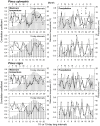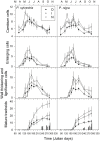Limited Growth Recovery after Drought-Induced Forest Dieback in Very Defoliated Trees of Two Pine Species
- PMID: 27066053
- PMCID: PMC4817349
- DOI: 10.3389/fpls.2016.00418
Limited Growth Recovery after Drought-Induced Forest Dieback in Very Defoliated Trees of Two Pine Species
Abstract
Mediterranean pine forests display high resilience after extreme climatic events such as severe droughts. However, recent dry spells causing growth decline and triggering forest dieback challenge the capacity of some forests to recover following major disturbances. To describe how resilient the responses of forests to drought can be, we quantified growth dynamics in plantations of two pine species (Scots pine, black pine) located in south-eastern Spain and showing drought-triggered dieback. Radial growth was characterized at inter- (tree-ring width) and intra-annual (xylogenesis) scales in three defoliation levels. It was assumed that the higher defoliation the more negative the impact of drought on tree growth. Tree-ring width chronologies were built and xylogenesis was characterized 3 years after the last severe drought occurred. Annual growth data and the number of tracheids produced in different stages of xylem formation were related to climate data at several time scales. Drought negatively impacted growth of the most defoliated trees in both pine species. In Scots pine, xylem formation started earlier in the non-defoliated than in the most defoliated trees. Defoliated trees presented the shortest duration of the radial-enlargement phase in both species. On average the most defoliated trees formed 60% of the number of mature tracheids formed by the non-defoliated trees in both species. Since radial enlargement is the xylogenesis phase most tightly related to final growth, this explains why the most defoliated trees grew the least due to their altered xylogenesis phases. Our findings indicate a very limited resilience capacity of drought-defoliated Scots and black pines. Moreover, droughts produce legacy effects on xylogenesis of highly defoliated trees which could not recover previous growth rates and are thus more prone to die.
Keywords: Pinus nigra; Pinus sylvestris; dendroecology; die-off; extreme climate event; forest resilience; xylem; xylogenesis.
Figures




References
-
- Antonova G. F., Cherkashin V. P., Stasova V. V., Varaksina T. N. (1995). Daily dynamics in xylem cell radial growth of Scots pine (Pinus sylvestris L.). Trees 10, 24–30. 10.1007/BF00197776 - DOI
-
- Antonova G. F., Stasova V. V. (1993). Effects of environmental factors on wood formation in Scots pine stems. Trees 7, 214–219. 10.1007/BF00202076 - DOI
LinkOut - more resources
Full Text Sources
Other Literature Sources

